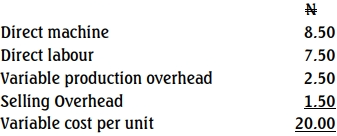- 12 Marks
Question
Grammar Limited manufactures product G of which the sales for the year 2015 was ₦25,000,000 at the unit price of ₦40. Production overhead and selling overhead were ₦2.50 and ₦1.50 per unit, respectively. The following additional information are available for the year 2015:
| ₦/unit | |
|---|---|
| Direct material used | 8.50 |
| Direct labour | 7.50 |
| Fixed production overhead | 6.00 |
| Fixed selling overhead | 2.00 |
| Administration overhead | 4.00 |
You are required to calculate:
i. Full production cost per unit and value
ii. Variable cost per unit and value
iii. Contribution per unit and value
iv. Break-even point in value
v. Total non-production cost per unit and value
vi. New break-even point (to the nearest Naira) if additional distribution expenses of ₦1.50/unit was incurred
Answer
i. Full production cost per unit and value:
Production in units = 25 000 000 / 4 = 625,000 units
ii. Variable cost per unit and value:

Value 625,000 x N20.00 = 12,000,000
iii. Contribution per unit and value

Value 625,000 x N20.00 = 125,000,000
iv. Break even point in value
![]()
![]() = N15,000,000
= N15,000,000
v. Total non-production cost per unit and value

Value 625,000 x N8.50 = N5,312,000
vi. New break-even cost point
= ![]()
= ![]()
= ![]() = N18,243,243
= N18,243,243
- Tags: Absorption Costing, Cost Calculations, Marginal Costing
- Level: Level 1
- Topic: Costing Methods
- Series: MAY 2016
- Uploader: Joseph


